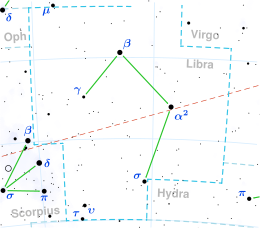천칭자리 시그마
Sigma Librae| 관찰 데이터 Epoch J2000.0EquinoxJ2000.0(ICRS) | |
|---|---|
| 콘스텔레이션 | 천칭자리 |
| 적경 | 15hm 04.21608s[1] |
| 적위 | - 25° 16° 55.0606°[1] |
| 겉보기 등급(V) | 3.20~3.46[2] |
| 특성. | |
| 스펙트럼형 | M2.5III[3] |
| U-B 색지수 | +1.94[4] |
| B-V 색지수 | +1.70[4] |
| 변수 유형 | SRb[2] |
| 아스트로메트리 | |
| 반지름 속도(Rv) | – 4.2 km[5]/s |
| 고유운동(μ) | RA: – 71.16[1] mas/년 Dec.: - 43.34[1] mas/년 |
| 시차()) | 11.31 ± 0.25 mas[1] |
| 거리 | 288 ± 6y (88 ± 2 pc) |
| 절대 등급(MV) | – 1.5[6] |
| 세부 사항 | |
| 덩어리 | 2.2[7] M☉ |
| 반지름 | 108[8] R☉ |
| 광도 | 1,820[7] L☉ |
| 표면 중력(log g) | 0.9 ± 0.3 kg[9] |
| 온도 | 3,596[7] K |
| 금속성 [Fe/H] | 0[9].00덱스 |
| 기타 명칭 | |
| 데이터베이스 참조 | |
| 심바디 | 데이터. |
천칭자리 시그마(δ Librae, 약칭 Sigma Lib, δ Lib)는 천칭자리에 있는 쌍성이다[11].겉보기 등급은 +3.[4]29로 육안으로 볼 수 있습니다.시차 측정에 따르면 이 시스템은 태양으로부터 약 288광년(88파섹) 떨어져 있으며 [1]오차범위는 2%입니다.이 거리에서는 가스와 먼지가 [9]개입하여 발생하는 소멸로부터 시각적인 크기가 0.20±0.17 감소한다.
이 두 가지 성분은 Sigma Librae A(공식적으로는 Brachium /brekikimm/,[12][13] 시스템의 전통적인 이름)와 B로 지정됩니다.
명명법
§ 천칭자리(라틴어: Sigma Librae)는 이 계의 현재 바이어 명칭으로, 1930년 [15]7월 31일 국제천문연맹(IAU)의 위원회 3에 의해 새로운 명칭이 합의될 때까지 현재 명칭이 부여되지 않았다.이 두 성분의 명칭은 WMC(Washington Multipleicity Catalog)가 다중성계를 위해 사용하고 국제천문연맹(IAU)[16]이 채택한 규칙에서 유래했다.
전통적인 라틴어 이름인 브라키움(팔)과 코르누(뿔)와 아랍어 이름으로는 독특하지 않은 작은 이름인 주벤 엘 게누비(알파 리브라에와 공유), 주벤 하크라비(감마 리브라에, 에타 리브라에 공유), 주반 알라카(공유)가 있었다.2016년 국제천문연맹은 별의 고유 명칭을 목록화하고 표준화하기 위해 WGSN을 [17]조직했다.WGSN은 다중 시스템 [18]전체가 아닌 개별 별에 적절한 이름을 부여하기로 결정했다.2017년 9월 5일 1차 성분인 Sigma Librae A에 브라키움이라는 이름을 승인하였다.앙카는 2016년 7월 29일 알파 페니시스의 이름으로 승인되었다.이제 둘 다 IAU가 승인한 스타 [13]네임 목록에 포함되어 있다.
중국어로 사형(死形)을 뜻하는 Shé Wii는 천칭자리, 50 히드라자리, 3천칭자리, 4천칭자리,[19] 12천칭자리 등으로 구성된 별자리를 말한다.그 결과, 천칭의 중국 이름은 천칭자(esh子, 영어: 사형 집행의 [20]일곱 번째 별)가 된다.
특성.
주성 시그마 천칭자리 A는 분광형 M2.5 [3]III로 적색 거성 단계에 있다.이 별은 20일의 단일 맥동 주기를 가진 [6]반규칙 변광성이다.이 값은 15-20분 정도의 짧은 시간 척도에서 0.10–0.15의 작은 진폭 변화를 나타내며, 2.5–3.[21]0시간의 간격에 걸쳐 반복 주기를 가진다.이러한 형태의 변동성은 별이 점근거성 가지에 있고 탄소와 [22]산소의 불활성 핵을 둘러싼 동심원 껍질을 따라 수소와 헬륨의 핵융합을 통해 에너지를 생성한다는 것을 나타냅니다.
동반성 시그마 천칭자리 B는 16등급으로 1분 이상 [11]떨어져 있습니다.
레퍼런스
- ^ a b c d e f van Leeuwen, F. (November 2007), "Validation of the new Hipparcos reduction", Astronomy and Astrophysics, 474 (2): 653–664, arXiv:0708.1752, Bibcode:2007A&A...474..653V, doi:10.1051/0004-6361:20078357, S2CID 18759600.
- ^ a b Samus, N. N.; Durlevich, O. V.; et al. (2009). "VizieR Online Data Catalog: General Catalogue of Variable Stars (Samus+ 2007-2013)". VizieR On-line Data Catalog: B/GCVS. Originally Published in: 2009yCat....102025S. 1. Bibcode:2009yCat....102025S.
- ^ a b Keenan, Philip C; McNeil, Raymond C (1989). "The Perkins catalog of revised MK types for the cooler stars". Astrophysical Journal Supplement Series. 71: 245. Bibcode:1989ApJS...71..245K. doi:10.1086/191373.
- ^ a b c Nicolet, B. (1978), "Photoelectric photometric Catalogue of homogeneous measurements in the UBV System", Astronomy and Astrophysics Supplement Series, 34: 1–49, Bibcode:1978A&AS...34....1N.
- ^ Wielen, R.; et al. (1999), "Sixth Catalogue of Fundamental Stars (FK6). Part I. Basic fundamental stars with direct solutions", Veröff. Astron. Rechen-Inst. Heidelb, Astronomisches Rechen-Institut Heidelberg, 35 (35): 1, Bibcode:1999VeARI..35....1W.
- ^ a b Yeşilyaprak, C.; Aslan, Z. (December 2004), "Period-luminosity relation for M-type semiregular variables from Hipparcos parallaxes", Monthly Notices of the Royal Astronomical Society, 355 (2): 601–607, Bibcode:2004MNRAS.355..601Y, doi:10.1111/j.1365-2966.2004.08344.x.
- ^ a b c Tsuji, T (2008). "Cool luminous stars: The hybrid nature of their infrared spectra". Astronomy and Astrophysics. 489 (3): 1271–1289. arXiv:0807.4387. Bibcode:2008A&A...489.1271T. doi:10.1051/0004-6361:200809869. S2CID 19007399.
- ^ Cruzalèbes, P; Jorissen, A; Rabbia, Y; Sacuto, S; Chiavassa, A; Pasquato, E; Plez, B; Eriksson, K; Spang, A; Chesneau, O (2013). "Fundamental parameters of 16 late-type stars derived from their angular diameter measured with VLTI/AMBER". Monthly Notices of the Royal Astronomical Society. 434 (1): 437. arXiv:1306.3288. Bibcode:2013MNRAS.434..437C. doi:10.1093/mnras/stt1037. S2CID 49573767.
- ^ a b c Dehaes, S.; et al. (September 2011), "Structure of the outer layers of cool standard stars", Astronomy & Astrophysics, 533: A107, arXiv:0905.1240, Bibcode:2011A&A...533A.107D, doi:10.1051/0004-6361/200912442, S2CID 42053871
- ^ "sig Lib -- Semi-regular pulsating Star", SIMBAD, Centre de Données astronomiques de Strasbourg, retrieved 2012-01-14.
- ^ a b c "Washington Double Star Catalog". United States Naval Observatory. Archived from the original on 14 February 2011. Retrieved 2 January 2018.
- ^ "brachium". Oxford English Dictionary (Online ed.). Oxford University Press. (가입 또는 참여기관 회원가입 필요)
- ^ a b "Naming Stars". IAU.org. Retrieved 16 December 2017.
- ^ Burnham, Robert (1978), Burnham's celestial handbook: an observer's guide to the universe beyond the Solar System, Dover Books on Astronomy, vol. 2 (2nd ed.), Courier Dover Publications, p. 1108, ISBN 0486235688.
- ^ "Report of Commissions: Ephemerides", Transactions of the International Astronomical Union, 4: 20, 1932.
- ^ Hessman, F. V.; Dhillon, V. S.; Winget, D. E.; Schreiber, M. R.; Horne, K.; Marsh, T. R.; Guenther, E.; Schwope, A.; Heber, U. (2010). "On the naming convention used for multiple star systems and extrasolar planets". arXiv:1012.0707 [astro-ph.SR].
- ^ "IAU Working Group on Star Names (WGSN)". Retrieved 22 May 2016.
- ^ "WG Triennial Report (2015-2018) - Star Names" (PDF). p. 5. Retrieved 2018-07-14.
- ^ (in Chinese) 中國星座神話, written by 陳久金.2005년 발행, ISBN 978-986-7332-25-7.
- ^ (중국어) AEEA (천문학 전시 및 교육 활동)2006년 6월 28일
- ^ Ruban, E. V.; Arkharov, A. A. (December 2010), "Microvariability and fast variability of stars. II. The semiregular red giants L2 Pup, 2 Cen, η Gem, and σ Lib", Astrophysics, 53 (4): 523–535, Bibcode:2010Ap.....53..523R, doi:10.1007/s10511-010-9144-7, S2CID 122054736.
- ^ Lebzelter, T.; Hron, J. (January 2008), "BRITE stars on the AGB", Communications in Asteroseismology, 152: 178–181, Bibcode:2008CoAst.152..178L, doi:10.1553/cia152s178
외부 링크
- Kaler, James B., "ZUBENHAKRABI (Sigma Librae = Gamma Scorpii)", Stars, University of Illinois, retrieved 2012-03-22



